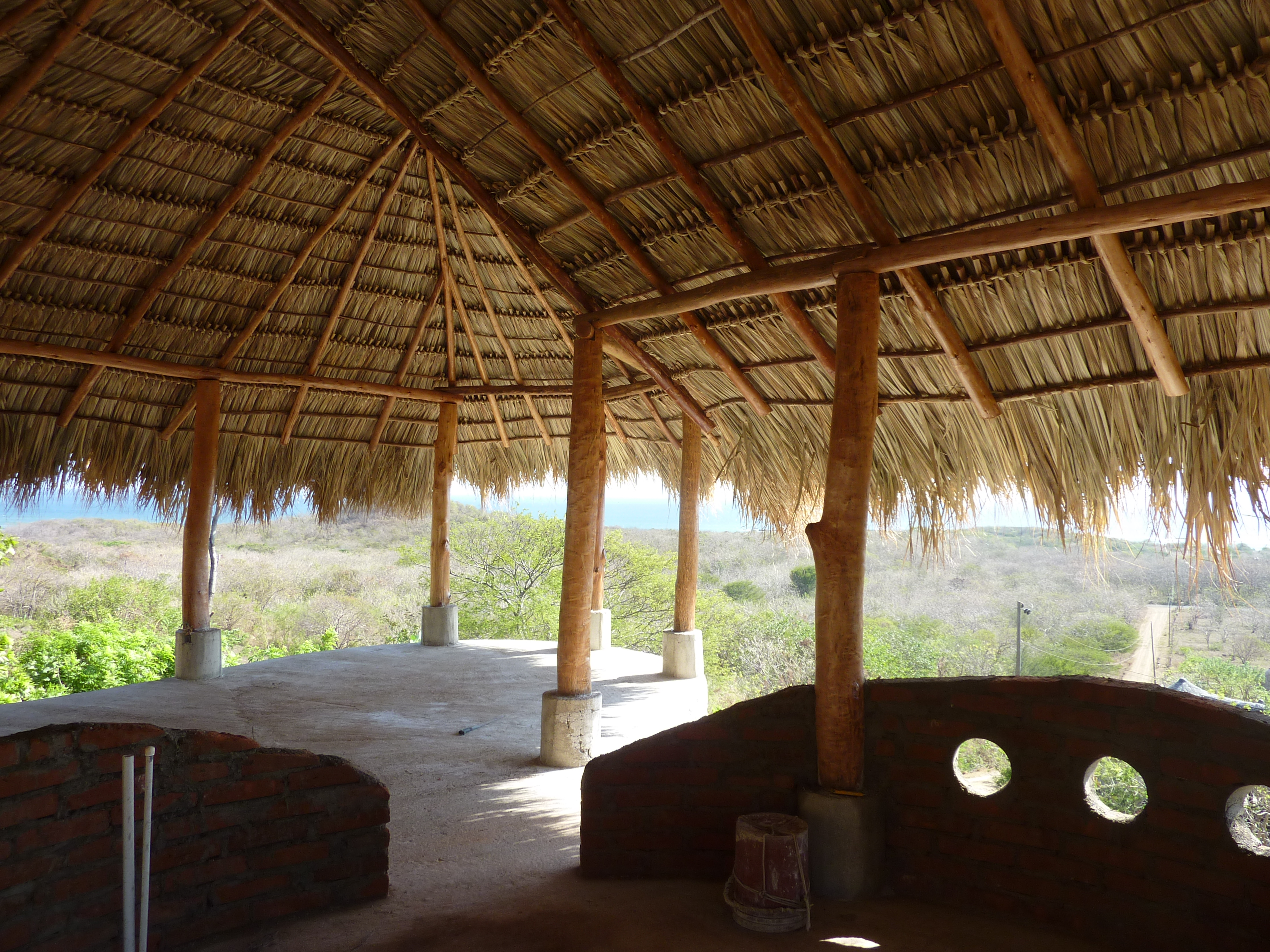

“A friend suggested a product I was unfamiliar with, so I decided to research and do some testing. The chemical name is calcium hydroxide… ca(oh)2 (calcium carbide), a by-product created in the production of acetylene. I went into Managua to a place that manufactures acetylene for welding. I found a big pool of jade coloured water, which is how a pool of lime looks. Calcium carbide lime when mined and then fired becomes calcium oxide co2 or hydrated lime. These two substances have the same structure and are from the same family. The company asked me if I wanted the gel or liquid. I bought the liquid as my original intention was to use it for painting the polypropylene tubes. The super adobe tubes deteriorate in the sun, so you must cover with plastic while you are building, or paint them to protect. Painting is so much easier but more expensive. Carbide is stupid inexpensive — $10 for a huge drum. As it turns out, I discovered you can use it as plaster. It turned to a nice thick paste after several weeks. I did several mixes and test patches on the walls until I found the right mix of coarse sand and carbide. It was rock solid after 2 months. This is a natural product and still allows the walls to breath while having the ability to repel rain. It is affordable to use in construction and I want to pass this on to the local Nicaraguans to aid in affordable housing.
The fotos are of the carbide used between the bags initially to build out and level the voids between the rows of bags. (Note Rosita claims that it is necessary to wear Austrian crystal drop earrings when applying the mix. stylin´). You want to leave it rough so the next layer can key into it better. Next we cover with chicken wire and then a coat of lime mixed with coarse sand. The final plaster will be lime and a very fine sand from lake Nicaragua. I am testing some lime mixed with blue ochre but cannot get the colour I want. My earthbag buddy in San Juan del Sur has an interesting array of test panels using different mixes of lime wash. I hope to do the same and find the right colour to paint with next season. Much interest from all walks of life with the build. I have been approached by several people interested in me building for them and acting as a consultant. Quien sabes?”
– Kevin

We are interested in this topic because we are looking to buy a property which has been coated with this, and wanted to know if this has any effect on health? Because this is obviously important
Calcium carbide treatment of food is extremely hazardous because it contains traces of arsenic and phosphorous. Once dissolved in water, the carbide produces acetylene gas. Acetylene gas may affect the neurological system by inducing prolonged hypoxia. But once the plaster has cured over time it may not pose much of a risk.
What do you mean by “it does not contain much of a risk”
The gas would dissipate quite quickly; the arsenic and phosphorous in the plaster would remain, but not likely to be consumed.
Please share the name of the manufacturer in Managua. I’ve tried GasPro, but they say they don’t sell it.
Any help would be GREATLY appreciated.
The only clue I have is he says, “I went into Managua to a place that manufactures acetylene for welding.”
Lol, yes…
I’m trying my best to work with that.
Thanks for the reply
i am also doing a research on the use of calcium carbide. i am impressed with the finished work produced by the plaster. could you please share to me the challenges faced during. the process
I did not know that you could paint the poly bags and that would protect them from the sun, how long would that protect the bags? Thank you
It should last as long as the paint (a long time).
One reader thinks this process may be dangerous and suggested talking to Patrick Webb of Plâtre.com.
How to treat calcium hydroxide poisoning http://www.nlm.nih.gov/medlineplus/ency/article/002910.htm
We too gave been thinking of using the carbide in a build in Dominica, (Caribbean). My consultant (Tom Burgess) and and I re doing experiments now. We have found that the carbide in a mix with scoria and a little lime hardened into a mightily solid, hard block in a short time.
We went to see the place where the stuff is produced. The first thing that struck me was the chemical smell. I notice that Kevin above says that this is a natural substance. What i’d like to know is might the stuff exude chemical fumes from internal walls for example, and might this be damaging to health in the long, if not the short, term.
Looking at working with lime here in Honduras…it is mined right down the road…just waiting for the right piece of land!
So how does this compare with using the lime that one buys in the hardware store? Maybe Kevin can offer some comparisons/insights? And is the chicken wire really necessary?
Im always intersted in new ways to cover walls,i read about using fiberglass window screen and covering it with a mix.
http=cease.colorado.edu-mc-edc-pdf-acrylic-%20concrete%20roofs.pdf
Im sorry my limited computer skills couldnt make this a clickable link.
acrylic concrete seemed easy,a frame with this draped over would be quik.
Owen: try this link http://freedownloadtopdf.com/pdf/Practical-Design-of-Reinforced-Concrete-Structures.html
Thanks for this info!! Exactly what I want to do in Panama…..